
VILJOENSDRIFT
What is Viljoensdrift? Its not a town or a village, perhaps settlement is a better term. Situated over the Vaal river just to the south of Vereeniging. GPS coordinates: 26.7322°S 27.9229°E elevation: 1449m
A settlement which has certainly seen better times, it used to have a primary school, a magistrates office, a post office and a NG church. Re spelling, sometimes one finds it as Viljoendrif, that is without a t at the end.
History

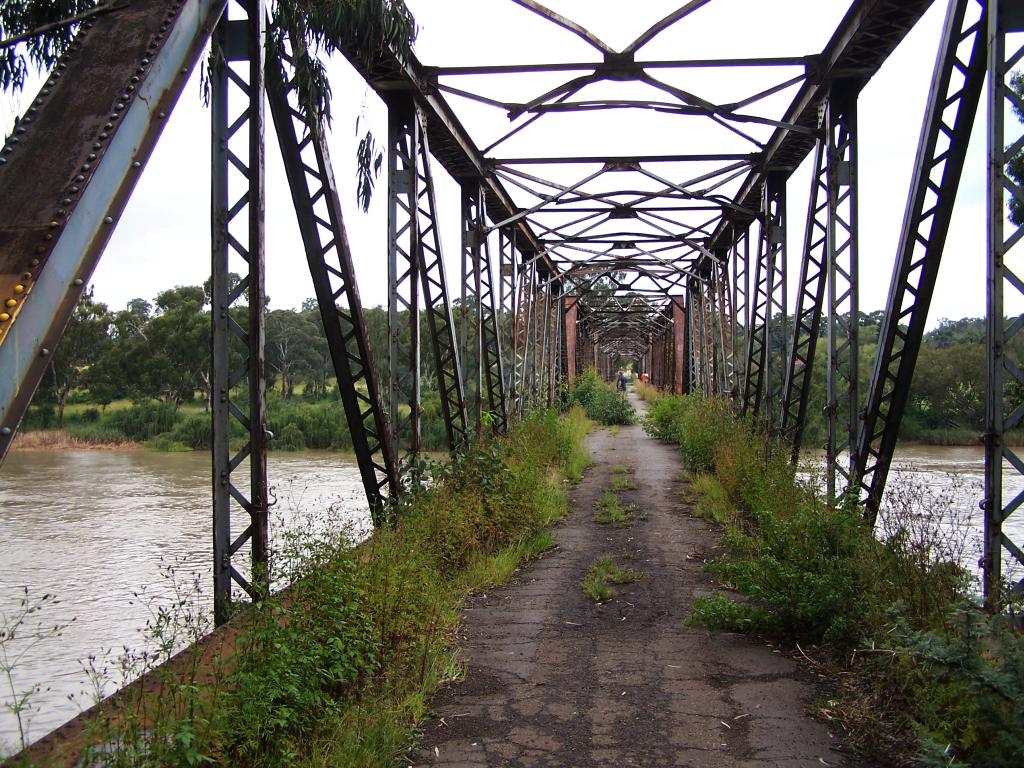 It started with the drift, that is a river crossing over the Vaal. To the left is a picture of the ferry as it was most likely in the early 1900rds, I found this in the archives of the Vereeniging museum. The 3rd picture shows what is left of the landing today. It is seen in the middle of the picture looking from the south (Free State side). Until a few years ago one could still see the steel post to anker the rope.
It started with the drift, that is a river crossing over the Vaal. To the left is a picture of the ferry as it was most likely in the early 1900rds, I found this in the archives of the Vereeniging museum. The 3rd picture shows what is left of the landing today. It is seen in the middle of the picture looking from the south (Free State side). Until a few years ago one could still see the steel post to anker the rope.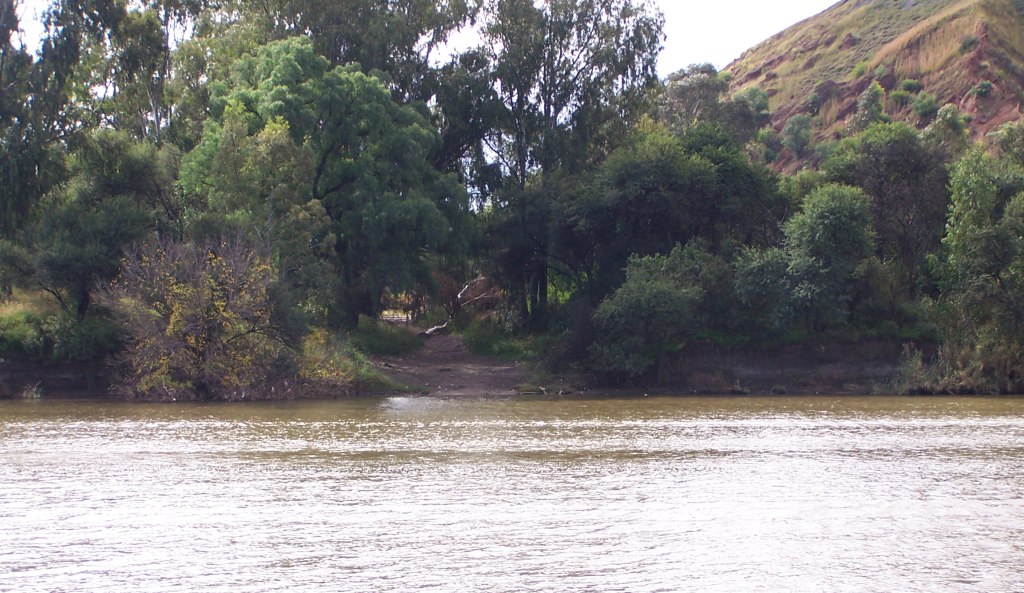
The crossing must have been active until 1927 when the road bridge (single lane) was constructed, but possibly longer, there is a picture of the pont dated 1953.
The settlement started with the discovery and mining of coal in the area.
Jozua Jacobus Viljoen
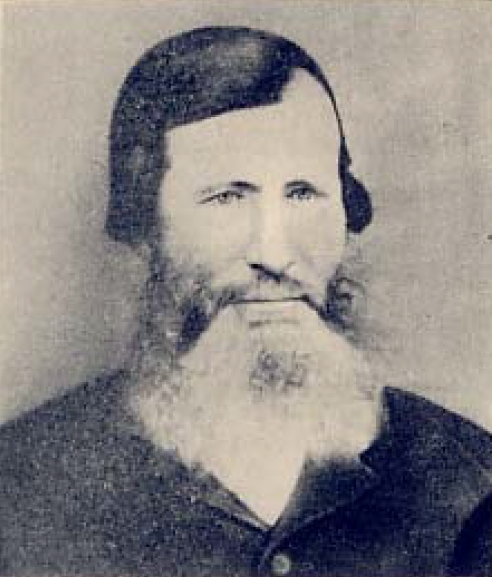 Reading in the sources, Ref 2 and 3, it becomes a bit confusing. The first occupier of the farm Witkop was Stephanus Viljoen. Witkop was the name of the farm where the drift was established in the early days. I have to assume that it was Stephanus who first established the drift, possibly with the help from his sons, one of them was Jozua Jacobus. But it was Hans Viljoen, another son, who advertised in 1857 that he has a ferry and is able to transport people, wagons and live stock over the Vaal on his fathers farm Witkop. The farm was also, possibly not officially, named Oshel (Ox Hell) because of the sand which made pulling an oxwagon hard for the span of oxen.
Reading in the sources, Ref 2 and 3, it becomes a bit confusing. The first occupier of the farm Witkop was Stephanus Viljoen. Witkop was the name of the farm where the drift was established in the early days. I have to assume that it was Stephanus who first established the drift, possibly with the help from his sons, one of them was Jozua Jacobus. But it was Hans Viljoen, another son, who advertised in 1857 that he has a ferry and is able to transport people, wagons and live stock over the Vaal on his fathers farm Witkop. The farm was also, possibly not officially, named Oshel (Ox Hell) because of the sand which made pulling an oxwagon hard for the span of oxen.
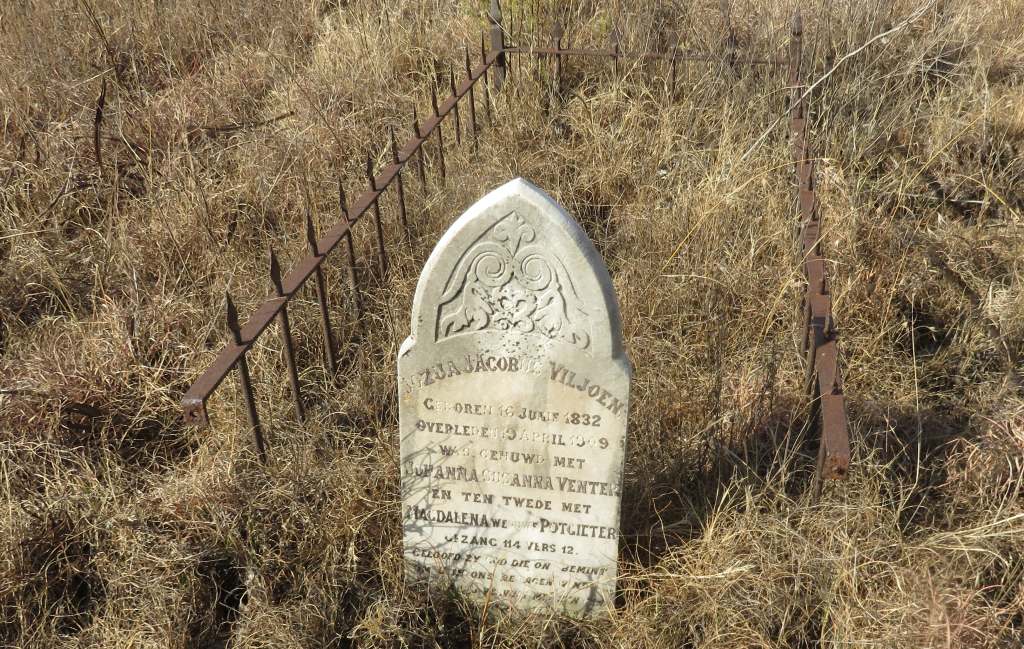 What happened to Hans is not known, what is known is that Jusua Jacobus sold the farm in 1885 for £1800 to the Vereeniging Estate, a company established by Sammy Marks and Isaac Lewis to extract the coal deposits of the area. A coal mine was established on the land
What happened to Hans is not known, what is known is that Jusua Jacobus sold the farm in 1885 for £1800 to the Vereeniging Estate, a company established by Sammy Marks and Isaac Lewis to extract the coal deposits of the area. A coal mine was established on the land
He later moved to Stephanus Rus, a farm between Heilbron and Oranjeville, where he died in 1909 at the age of 77. His gravestone reads: Jozua Jacobus Viljoen, born 16-June-1832, died 9-April-1909, was married to, Johanna Susanna Venter, and second with, Magdalena widowed Potgieter.
Railway station

 The line from Bloemfontein came to Viljoensdrif in 1892. And the crossing over the Vaal was in 1893, thus for about a year Viljoensdrif station was the end point for goods and passengers to Johannesburg. At the time of our last visit they still had the manual lever system to set signals and switches. There was talk of the station being automated and controlled from somewhere else down the line. During a visit in March 2013 it transpired that there was work in progress and the system would be centralised by May the same year. Thus good bye to the levers.
The line from Bloemfontein came to Viljoensdrif in 1892. And the crossing over the Vaal was in 1893, thus for about a year Viljoensdrif station was the end point for goods and passengers to Johannesburg. At the time of our last visit they still had the manual lever system to set signals and switches. There was talk of the station being automated and controlled from somewhere else down the line. During a visit in March 2013 it transpired that there was work in progress and the system would be centralised by May the same year. Thus good bye to the levers.
A relic from the days of apartheid is the pedestrian bridge over the rails, divided in the middle so to keep black and white apart.
Magistrate and Post Office
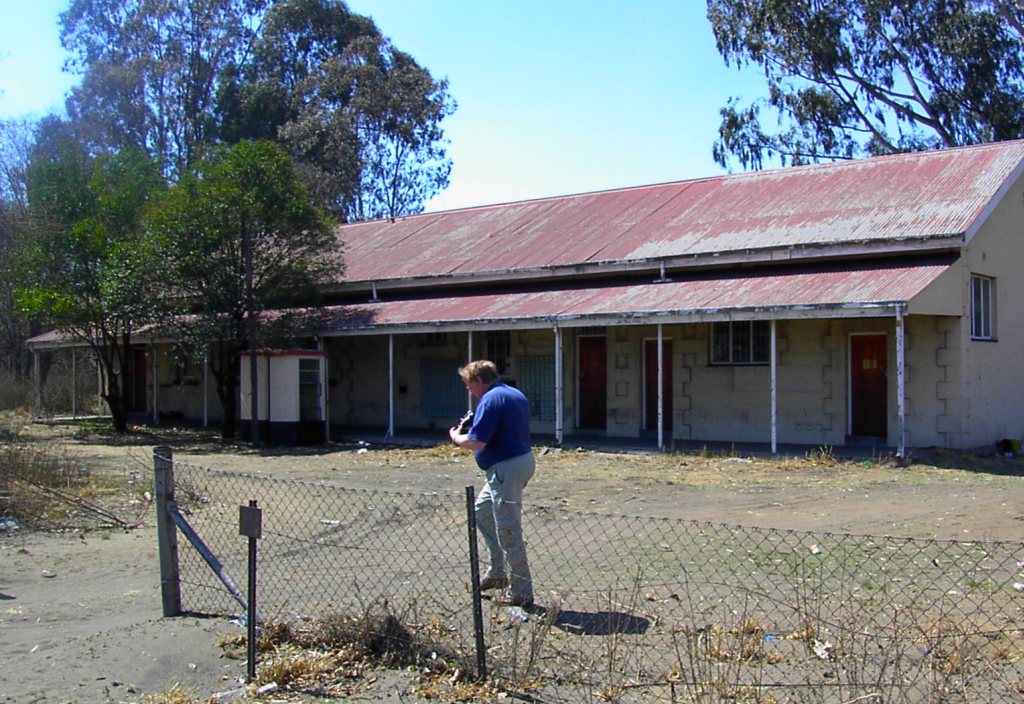
 This first picture of the building that used to house the magistrate and the post office is from 2004. It has changed a bit since then, not for the better. The two telephone booth are gone, I had my eyes on them for a while but could see no way of getting them away from there. When eventually they disappeared I could see that it was a hell of a job to get them out, they were stuck in a concrete block and had to chipped out with heavy machinery.
This first picture of the building that used to house the magistrate and the post office is from 2004. It has changed a bit since then, not for the better. The two telephone booth are gone, I had my eyes on them for a while but could see no way of getting them away from there. When eventually they disappeared I could see that it was a hell of a job to get them out, they were stuck in a concrete block and had to chipped out with heavy machinery.
The building has been taken over by squatters. The magistrates court room still had some of the insides, like the dock for the accused and the pedestal to elevate the magistrate. These items are now gone, but the coat of arms is still there. Also the post office next door has now been occupied.
Primary school

 The school was opened in 1904 with Miss Jackson as principle.
The school was opened in 1904 with Miss Jackson as principle.
The hall and two class rooms of the Viljoensdrift Primary School is still standing, although not in a good condition. Other class rooms used to be prefabricated buildings are all gone.
A memorial pyramid of stones at the entrance with the year 1967 inscribed is a reminder of the disaster that struck the school when a tornado riped off the roof. The picture on the right shows this monument with one of the former pupils. Mel Jones attended the school in 1936/37.
Cemeteries
There are three cemeteries.
the old cemetery
Lawrence Alexander
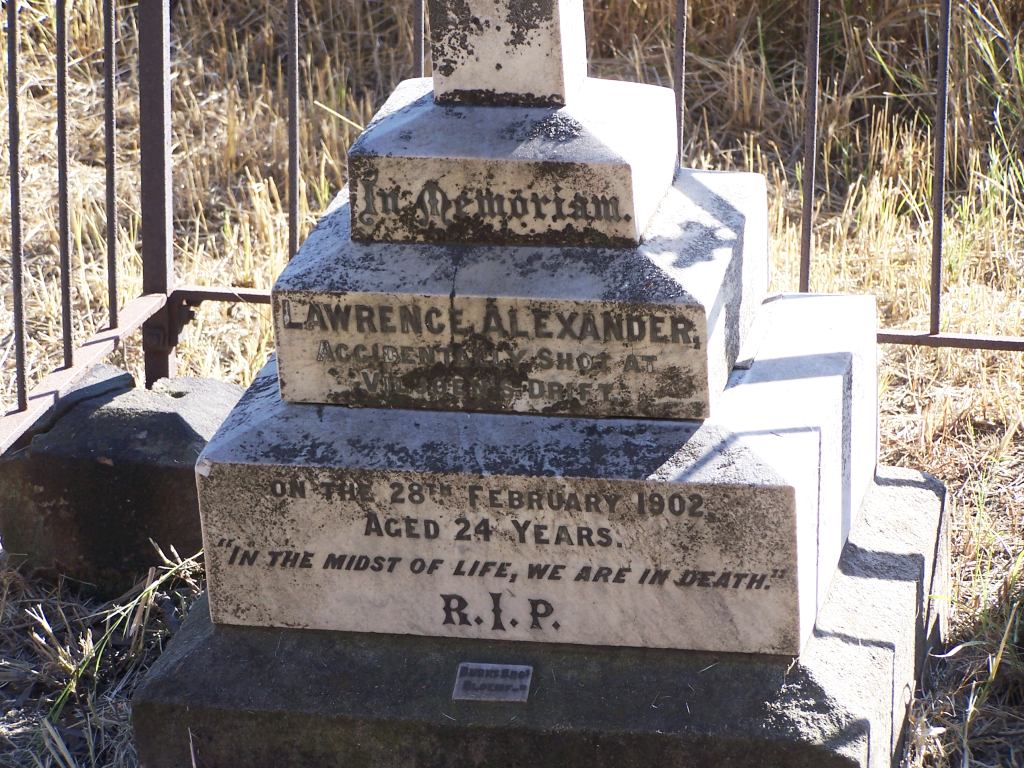 Of interest in this grave yard is the grave of Andrew Lawrence, a victim of the Boer War. He was accidentally shot when he approached the
Of interest in this grave yard is the grave of Andrew Lawrence, a victim of the Boer War. He was accidentally shot when he approached the 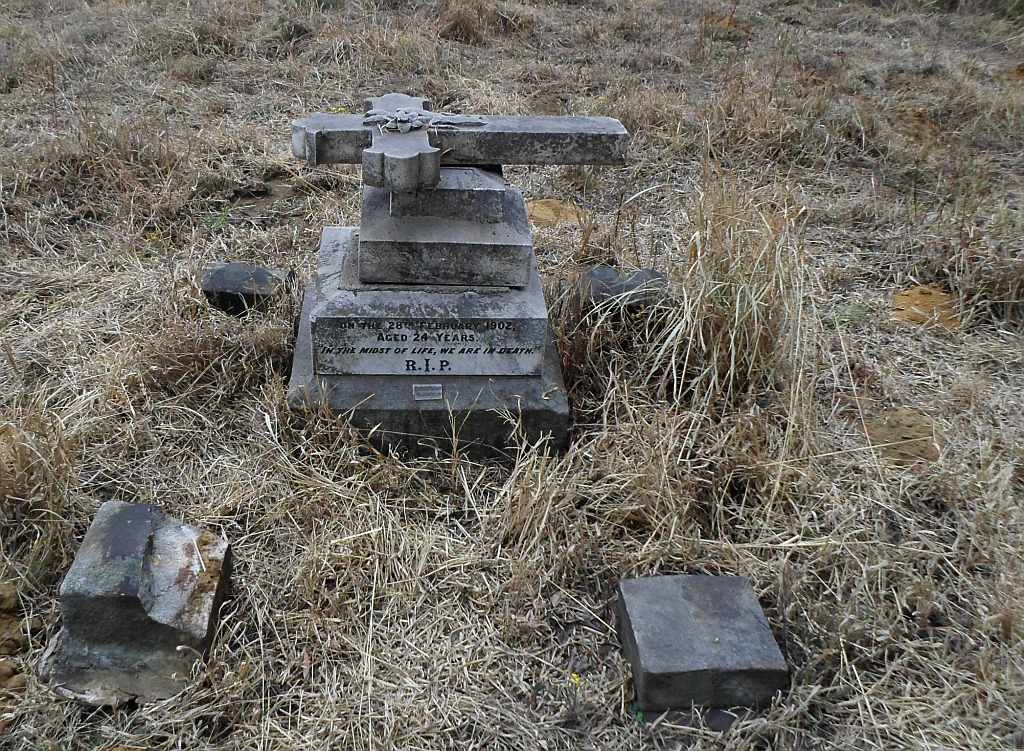 British post at the drift. That was on the 28 Feb 1902.
British post at the drift. That was on the 28 Feb 1902.
There is one lone British grave from the Boer War, the inscription is unreadable.
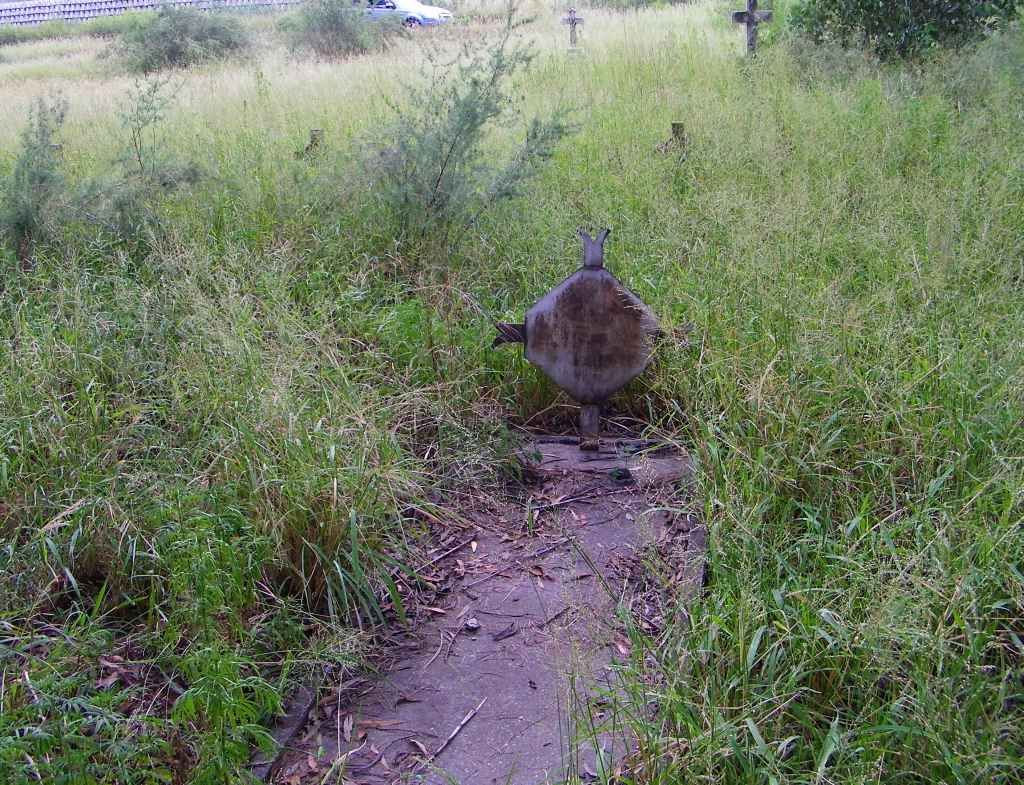 Postscript: it has just come to my attention (June 2014) that the Lawrence grave has been vandalised (picture taken by Twin Mosia). Obviously it was for the scrap metal, but in the process the cross has been toppled. My opinion, if the thieves want the scrap metal, take it, but why push over the cross? Very sad, the depravity of the thieves.
Postscript: it has just come to my attention (June 2014) that the Lawrence grave has been vandalised (picture taken by Twin Mosia). Obviously it was for the scrap metal, but in the process the cross has been toppled. My opinion, if the thieves want the scrap metal, take it, but why push over the cross? Very sad, the depravity of the thieves.
Vaal Dam dead
There are two rows of graves, all very much the same looking. I have deciphered some of the plaques, what follows is thus just a sample.
Sarel Johannes van der Berg; gebore 9.9.1914 oorlede 9.12.1934
Christian Lourence Lombard; gebore 10-5-1916 oorlede 12-2-1935
Gert Jacobus du Plessis; gebore 28-12-1911 oorlede 29-11-1935
William George Smith; born 12-5-1915 died 12-9-1936
Frederik Richardt Zeelie; gebore 29-10-1911 oorlede 24-4-1936
In loving memory; of my dear wife Kate Lamont; born12-12-1895 died 20-1-1937; sadly missed by husband and children
With the exception of the last inscription, they were all young men of ages 19 to 24. Could they all have died in accidents on the costruction site of the Vaal Dam?
the non-white cemetery
Yes, in the old days the dead one's were separated by race, that was apartheid.
An odd grave is that of J.J.Digojane *10 8 1898 † 8 4 1964. It is odd because it is far away from the other graves and in a different direction. All the graves are facing the rising sun, east, whilst this one faces north. Could it be a Muslim grave facing Mekka?
the mine cemetery
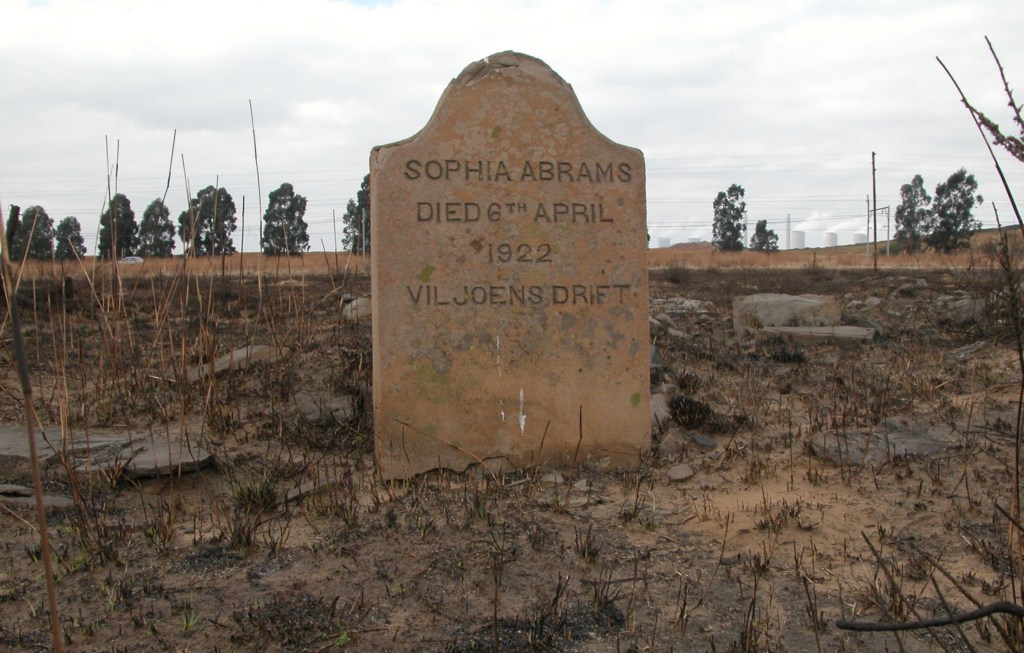
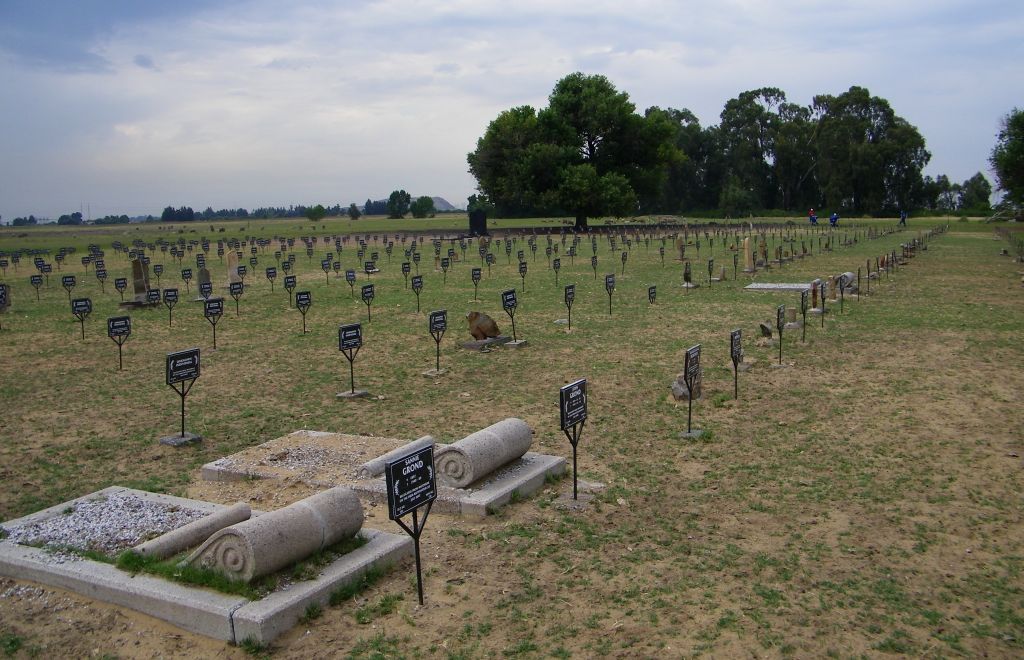 This is a cemetery originally on the grounds of the mine. When the mine was extended to over the road, that is the area between the R82 and the Vaal river, the cemetery there had to be moved. All the bones were re-buried near the village of Viljoensdrift, very neat with individual crosses at each grave indicating name and relevant date where available.
This is a cemetery originally on the grounds of the mine. When the mine was extended to over the road, that is the area between the R82 and the Vaal river, the cemetery there had to be moved. All the bones were re-buried near the village of Viljoensdrift, very neat with individual crosses at each grave indicating name and relevant date where available.
The first picture shows one of the grave stones in the old location and the second the new grave yard at Viljoensdrift.
Church
 The congregation of the NG church was founded in 1948, the church hall (still standing) was built in 1950 and the church itself, I am not sure, sometime in the 60's, I think. The church is not in regular use anymore, the congregation has amalgamated with the one in Vaalpark. Most likely due to dwindling numbers. Something we have been observing all over the area. Thinking about it, there was Vaal Power Station, the plant is gone, the village remains but is almost totally black. And White City, a collection of about 20 houses where the new mine extension is now, all gone. And in Viljoensdrift itself there are possibly two houses still occupied by white people.
The congregation of the NG church was founded in 1948, the church hall (still standing) was built in 1950 and the church itself, I am not sure, sometime in the 60's, I think. The church is not in regular use anymore, the congregation has amalgamated with the one in Vaalpark. Most likely due to dwindling numbers. Something we have been observing all over the area. Thinking about it, there was Vaal Power Station, the plant is gone, the village remains but is almost totally black. And White City, a collection of about 20 houses where the new mine extension is now, all gone. And in Viljoensdrift itself there are possibly two houses still occupied by white people.
During one of our visits we were told that the church now has special services for bikers, not sure this is still the case.
Worlds War I memorial
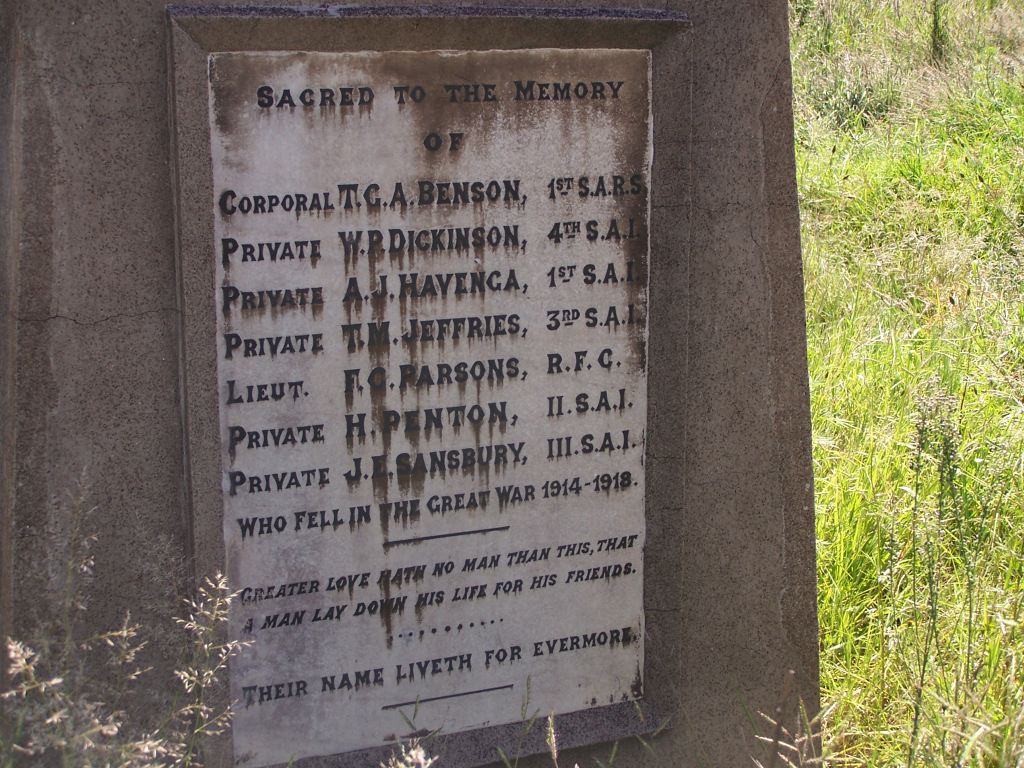
 On the station platform is a monument, it commemorates the soldiers from this area who lost their lives in the first world war. And here is my gripe, it just illustrates the futility of wars, here these guys from the Viljoensdrift coal fields were sent all the way to France to fight my grandfather and died (my grandfather, by the way, also didn't make it), for what?
On the station platform is a monument, it commemorates the soldiers from this area who lost their lives in the first world war. And here is my gripe, it just illustrates the futility of wars, here these guys from the Viljoensdrift coal fields were sent all the way to France to fight my grandfather and died (my grandfather, by the way, also didn't make it), for what?
The picture on the right was taken during the inauguration of the monument in 1921.
Maccauvlei
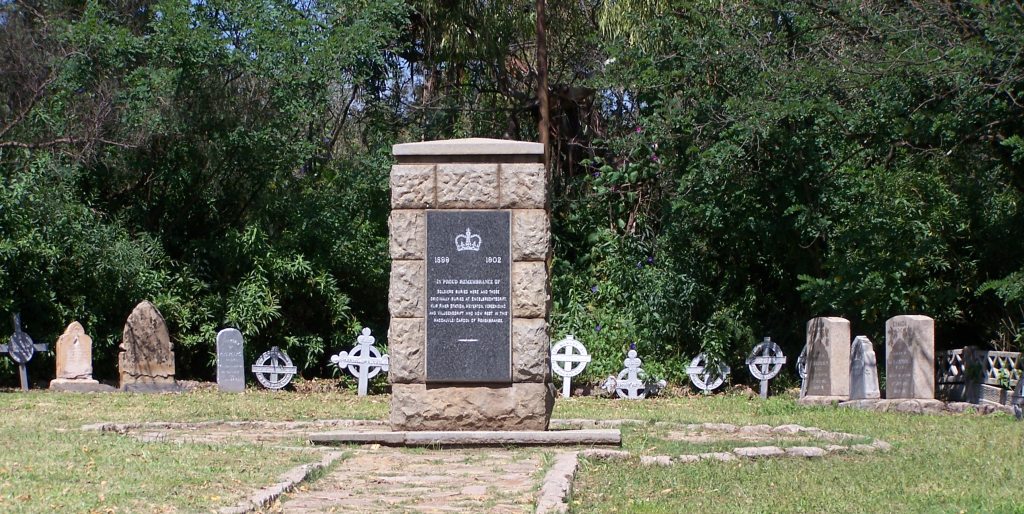
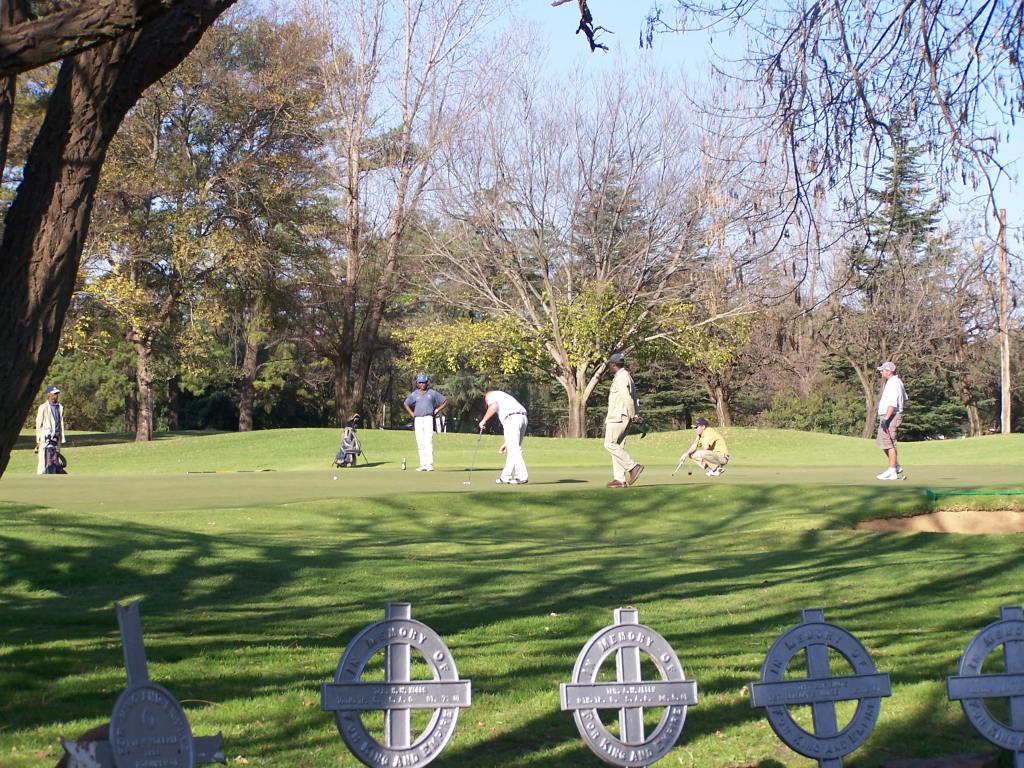 Maccauvlei is well known for the golf course. The farm was originally bought from the Free State by Carl August Pistorius in 1844. The existence of the large Oak trees is due to him. He brought acorn back from one of his business trips to Pietermaritzburg. He sold the farm in 1881 to the mining company owned by Sammy Marks to establish the coal mine Cornelia. The sale was not an easy one, Mr Pistorius was driving a very hard bargain and eventually sold it for the so far unheard of amount of 15500 pounds to be paid in gold coins.
Maccauvlei is well known for the golf course. The farm was originally bought from the Free State by Carl August Pistorius in 1844. The existence of the large Oak trees is due to him. He brought acorn back from one of his business trips to Pietermaritzburg. He sold the farm in 1881 to the mining company owned by Sammy Marks to establish the coal mine Cornelia. The sale was not an easy one, Mr Pistorius was driving a very hard bargain and eventually sold it for the so far unheard of amount of 15500 pounds to be paid in gold coins.
Indirectly Sammy still had something to do with the establishment of the golf course. It was two of his sons, Louis and Teddy Marks, who during a holiday on the coast learned to play golf and liked it so much that they wanted their own golf course. The course was designed and built by George Peck. And a bit later modified by the professional golfer Major SV Hotchkin.
At the time when it was established and a few years after it was the only inland golf course in SA. It has to this day maintained a high standard.
A point of interest on the golf course is the British war cemetery from the Boer War. It is next to the fairway of no.4. This cemetery was established a number of years after the war, with the remains of fallen soldiers collected from different locations in the area.
One can find a more detailed description and history of the Maccauvlei golf club
ps: January 2018, all the steel crosses have been uprooted and taken away, I presume, to be sold as scrap.
Reference:
Ref 1: JC de Bruin 'Viljoendrif Gedenk-Album', printed 1954 by 'Die Drif Drukkery'; just a note here: JC de Bruin was the principle of the school at that time and his hobby was printing.
Ref 2: 'Standard Encyclopedia of Southern Africa', 1972
Ref 3: Ramon Lewis Leigh, Vereeniging South Africa, book issued to commemorate 75 years of Vereeniging, 1968